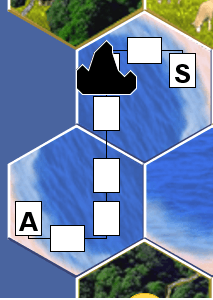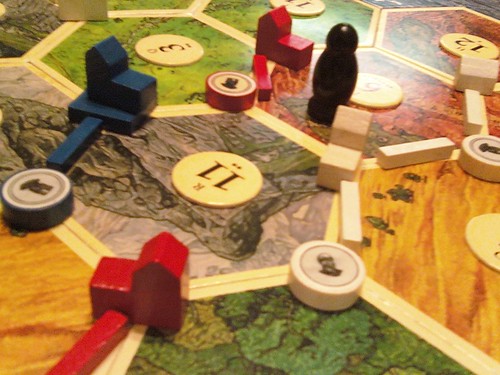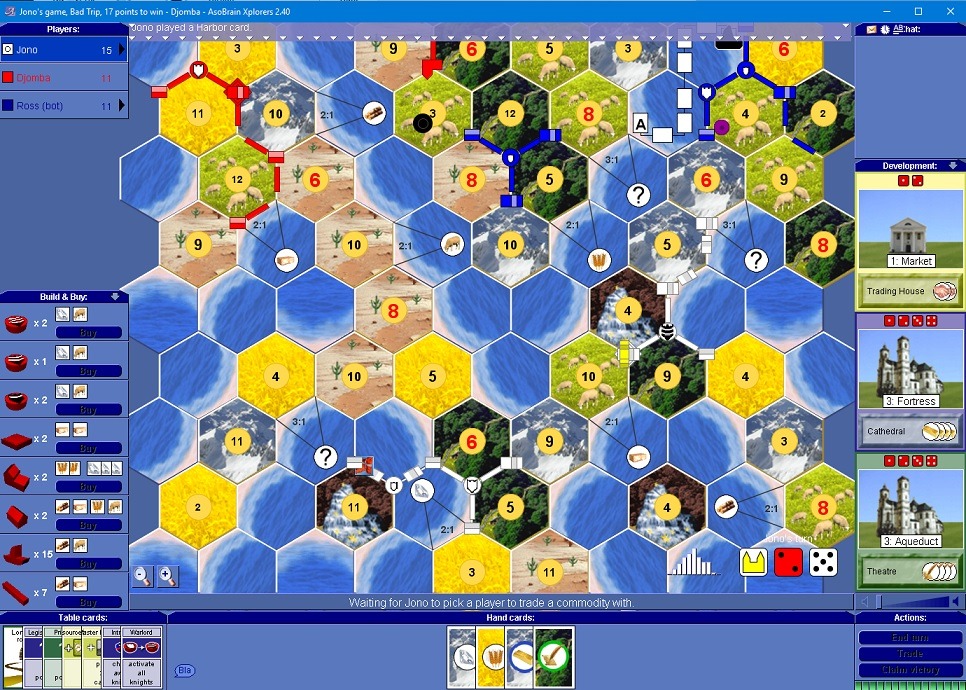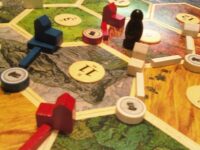Cities and Knights is an expansion of Settlers of Catan, released in 1998. It shifts the gameplay of Catan into more of a city-development game with elements of fighting barbarians and a deeper element of interaction with other players. New game mechanics are introduced giving players more options when playing. Let’s see what is Cities and Knights all about.
New Gameplay Mechanics in Cities and Knights
City improvements and commodities
Having a city is pivotal in the expansion, therefore players start with one city and one village. Cities produce commodities (on top of resources). There are 3 commodities: cloth (from pasture), coin (from mountains), and paper (from the forest). Commodities can be traded just like resources.
Using commodities, cities can be improved in 3 areas, with each having 5 levels. Every higher-level provides additional benefits like a higher chance to receive progress cards and special abilities. When a city reaches level 4 in any area, it becomes a metropolis, granting 2 more victory points.
Another new improvement is the city walls. Each city can have one, and each wall increases the maximum amount of resource cards in hand by 2, to a maximum of 13.
Knights and barbarians
Knights are now no longer just cards – they are tokens you buy (for 1 ore and 1 sheep) and place on an intersection on the board. They can be promoted up to two times, to make them even more powerful.
When a knight is activated (costs 1 grain), it can perform actions such as moving, chasing away the robber, or fighting other knights.
A third die, event die is introduced. It serves to determine whether barbarians make any progress toward the island.

Barbarians are an important new game mechanic: each time their ship lands on the island, a fight between barbarians and knights is initiated. If knights win, the player who contributed the most receives a defender card, which is worth one victory point.
Should barbarians win, the player with the fewer knights loses a city – it’s demoted to a village. After each barbarian attack, all knights are deactivated. To restore their functionality, one grain per each is needed (or a special progress card).
Progress cards
The second purpose of the third die is to determine the distribution of progress cards. They work similarly to development cards but are significantly more powerful, specialized, and oriented toward harming other players.
Just like commodities and city improvements, progress cards come in three flavors: technology (cards like Inventor, Irrigation or Mining, etc.), commerce (Merchants and Monopolies, etc.), and politics (Spy, Deserter, Saboteur, etc.).
How does it feel to play?
I admit – the first couple of times I played Cities and Knights, I was confused and overwhelmed by all the things to do.
The Player has a lot of options during his turn. Building roads (and ships, if you combine Cities and Knights with Seafarers), settlements, and upgrading to cities are still here, but now you have to build knights to protect your property, upgrade your cities and be wary of barbarians’ progress.
All that with a combination of looking out for other players who try to do the same, obstructing them, using political cards on them, and still trying to keep them friendly enough to trade with you.
On average, you will have more resource cards in your hand than in the base game, but of course not enough to advance in all aspects. Wise decisions like using that clay to build walls instead of roads (or vice-versa?), deciding to use the grain to activate your knights instead of upgrading to a city (or hoping the barbarians don’t make it to the island yet and risking it) or trading them away for commodities are decisions that win or lose a game.

Players’ turns last longer and it can take a while for the turn to come to you, especially with 5-6 players extension. That can be a bit frustrating, but not nearly as much as when barbarians raid your city, another player sabotages your city, or uses a progress card to destroy your road. You have to be careful who you play Cities and Knights with, as back-stabbing moves like this can quickly turn an enjoyable evening into a nightmare.
The endgame is pretty chaotic – with all the progress cards in the game by now, cards and knights are moving all over the place – and luck plays a significant part in this too (remember, that there are now three dice). All that combined means that a game of Cities and Knights lasts longer (around the 2-hour mark).
If Seafarers feels like a natural expansion for the base game, Cities and Knights doesn’t have that Catan feeling and feels much more like a different game. It’s up to you to decide if that suits you.
Did you know Catan is still on the list of most popular board games?
Who it’s for and who it’s not for?
Cities and Knights take quite a lot more skill to be played. If you are a fan of Catan and you have a couple of like-minded friends (who are not afraid to put time and effort into the game), then go ahead. You will have a lot of fun building your cities and playing political games with each other.
On the other hand, if you are more of a casual player or not a die-hard Catan fan (and you play with players who are also casual or novices), then Cities and Knights are going to be too much for you. It takes a bit of learning and adapting. I believe you get much more value out of your time if you go for the base game with Seafarers expansion or another board game altogether.
Extensions and Compatibility
As with other expansions, a 5-6 player extension is also available, and it works the same way. You need the base game, base game extension, and Cities and Knights expansion for this extension to work.
For a 3-4 players game, you only need the base game and Cities and Knights expansion.
Cities and Knights are also compatible with Seafarers – some special rules apply in this case.

Conclusion
I tried to keep this review as brief as possible and focus on the important bits. I am aware I have left out some finer game mechanics and elements (such as the trader or the development flip-charts), but the point wasn’t to recite the rules but to give you my opinion on how the game feels. Hopefully, I succeeded.
Do you like what you just read? Consider subscribing for more content:

I think this cities and knights catan expansion reviewis well written. Its going to be my first time playing the game and I like the fact that you say the game is tasking. I lobe taking on new challenges and I like that I’ll be building a city. This sounds a bit similar to clash of clans in my own opinion. Great review here. O will personally give it a try. Thank you for sharing your opinion on the game play and how it feels to play the game.
Thanks for the comment and check my reply on the comment below!
I had never heard Cities and Knights before but it seems like a fun game to play. I always loved similar games that are more deep and need more thought while interacting with your fellow players rather than simple straightforward games that don’t put your brain to work. I might check this out to find more details about it. Thank you for the sharing.
Check this article then: https://victoryconditions.com/games-on-asobrain-com-xplorers/
You can practice for free here.
I’m glad that you compared this to Catan. I have played that and find it mentally challenging. More mentally challenging that I like for a board game. So, I don’t think Cities and Knights will be my next go-to board game. However, I do know a few people who may love this game. Some people just love more complex games and from your description, it sounds like Cities and Knights is a bit more complex.
You’re absolutley spot on that it’s a bit more complex than a bas Catan game. But it’s not impossible to learn. 🙂
Thanks for yet another interesting article about Cities and knights and Catan expansion, i really think the expansion is going to be fun, to be sincere, I haven’t played it before but by virtue of how you’ve described it here, i was able to picture what it’s gonna look like. One of the reasons why I love it is that it’s different from the core game. I’ll make sure to check it out, thanks.
Thanks for the comment and you’re welcome!
Cities and knights seems interesting enough and seeing that it is just an expansion on catans, it would be too easy for us since I have quite a lot of friends who enjoy playing Catan. Hence, this is great and I value this a lot. Thumbs up to you for sharing all these here
Good to hear you found it informative!
Three of us have played so many games of cities and knights over the years along with the seafarers expansion at the same time
We found base Catan boring and even when seafarers was added but then also adding this was a game changer
The main difference is that it is far more interactive between players which base Catan lacks
It took a while to get the hang of it but has been well worth while
We have made some small but important house rule changes
I have only ever played with three
With four I think we would be bored
5/6 sounds like hell
Three is good because if one person pulls ahead the other two can often cooperate to pull them back a bit
My rating for 3 players and both expansions and our house rules is 10 out of 10
I’m curious to hear about house rules. What did you change?